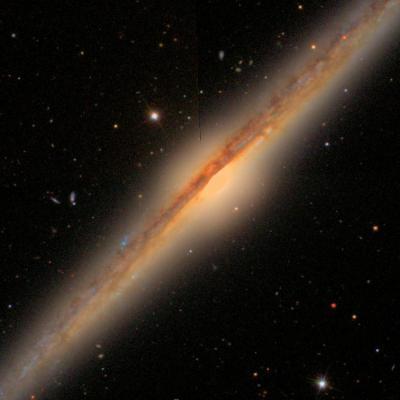Galaxy Zoo 2, the second phase of a crowdsourcing effort to categorize galaxies in our universe, has leveraged more than 83,000 citizen scientists to obtain over 16 million galaxy classifications and information on more than 300,000 galaxies.
That's what you get when you ask the public for help in learning more about our universe. Computers are good at automatically measuring properties such as size and color of galaxies, but more challenging characteristics, such as shape and structure, can only be determined by the human eye.
An international group of researchers has just produced a catalog of this new galaxy data, 10 times larger than any previous catalog of its kind, and a paper describing the project and data was published today in the Monthly Notices of the Royal Astronomical Society.

Galaxy NGC 4565 is a disk galaxy viewed at nearly an edge-on angle. The darker line running down the middle of the disk is a feature called a dust lane, identified by users in the Galaxy Zoo 2 project. Dust in galaxies can act as shadows, absorbing the starlight from the center of the galaxy and showing up as a dark feature. Galaxies like these are of particular interest for their links to star formation and the speeds at which galaxies rotate. Credit: University of Minnesota
"This catalog is the first time we've been able to gather this much information about a population of galaxies," said Kyle Willett, a physics and astronomy postdoctoral researcher in the University of Minnesota's College of Science and Engineering and the paper's lead author. "People all over the world are beginning to examine the data to gain a more detailed understanding of galaxy types."
Between Feb. 2009 and April 2010, more than 83,000 Galaxy Zoo 2 volunteers from around the world looked at images online gathered from the Sloan Digital Sky Survey. They answered questions about the galaxy, including whether it had spirals, the number of spiral arms present, or if it had galactic bars, which are long extended features that represent a concentration of stars. Each image was classified an average of 40-45 times to ensure accuracy. More than 16 million classifications of more than 300,000 galaxies were gathered representing about 57 million computer clicks.
When volunteers were asked why they got involved in the project, the most common answer was because they enjoyed contributing to science. Researchers estimate that the effort of the volunteers on this project represents about 30 years of full-time work by one researcher.
"With today's high-powered telescopes, we are gathering so many new images that astronomers just can't keep up with detailed classifications," said Lucy Fortson, a professor of physics and astronomy in the University of Minnesota's College of Science and Engineering and one of the co-authors of the research paper. "We could never have produced a data catalog like this without crowdsourcing help from the public."
Fortson said Galaxy Zoo 2 is similar to a census of the galaxies. With this new catalog, researchers now have a snapshot of the different types of galaxies as they are today. The next catalog will tell us about galaxies in the distant past. The catalogs together will let us understand how our universe is changing.





Comments